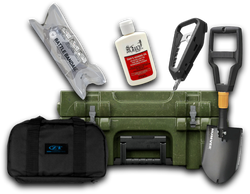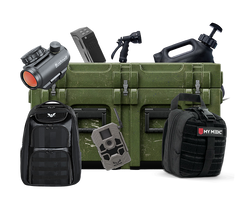How Does a Lever Action Rifle Work?
Table of Contents
- Introduction
- Mechanics of Lever Action Rifles
- Historical Evolution
- Comparative Analysis
- Practical Applications
- Modern Innovations
- Conclusion
- FAQ
Introduction
Imagine standing in a dense forest, the sun filtering through the leaves, while the quiet of nature surrounds you. The thrill of the hunt is not just about the quarry; it’s about the tools that accompany you. Among these tools, the lever action rifle holds a special place, combining historical significance with mechanical ingenuity. Have you ever wondered how this iconic firearm operates?
The lever action rifle, renowned for its unique loading and firing mechanism, has carved its niche in the world of firearms since its inception. While modern firearms have diversified, the lever action rifle remains a favorite among hunters and enthusiasts due to its reliability, speed, and ease of use. This blog post will delve into the intricacies of how lever action rifles work, covering their mechanical operations, historical evolution, and practical applications, while seamlessly integrating references to Crate Club's tactical gear offerings.
By the end of this comprehensive guide, you will have a profound understanding of the mechanics behind lever action rifles, their historical context, and why they continue to be relevant today. We’ll explore the following key areas:
- Mechanics of Lever Action Rifles: Understanding the core components and how they function together.
- Historical Evolution: A look at the development of lever action rifles from their inception to the present.
- Comparative Analysis: How lever action rifles stack up against other firearm types.
- Practical Applications: Exploring scenarios where lever action rifles excel.
- Modern Innovations: Recent advancements in lever action rifle technology.
- Community Engagement: How the Crate Club community thrives on tactical knowledge sharing.
Let’s embark on this journey into the world of lever action rifles, uncovering the mysteries of their operation and celebrating their legacy in the tactical and survival community.
Mechanics of Lever Action Rifles
The Core Components
At the heart of every lever action rifle lies a series of mechanical components that work together to facilitate the loading, firing, and ejecting of cartridges. Understanding these elements is essential to grasping how lever action rifles operate.
-
Receiver: The receiver houses the trigger mechanism, firing pin, and other essential components. It serves as the central hub for the rifle's mechanical operations.
-
Lever: Positioned below the trigger guard, the lever is the most recognizable feature of a lever action rifle. When pulled down, it unlocks the action and cycles the bolt.
-
Bolt: The bolt is responsible for chambering the cartridge and locking it in place for firing. It moves backward during cycling to eject the spent cartridge and forward to chamber a new one.
-
Magazine: Most lever action rifles utilize a tubular magazine located under the barrel, allowing for multiple rounds to be stored and fed into the chamber.
-
Firing Pin: Once the cartridge is chambered, the firing pin strikes the primer, igniting the powder and propelling the bullet down the barrel.
The Operation Cycle
The operation of a lever action rifle can be broken down into several steps, illustrating the elegant mechanics at play:
-
Lever Activation: Pulling the lever down unlocks the action. This movement is pivotal as it initiates the entire cycle.
-
Ejecting the Spent Cartridge: As the lever is pulled down, the bolt moves backward, ejecting the spent cartridge case from the chamber.
-
Chambering a New Round: As the lever is pushed back up, the bolt moves forward, drawing a new cartridge from the magazine and chambering it.
-
Firing: With the cartridge properly seated in the chamber, pulling the trigger releases the firing pin, striking the primer and igniting the cartridge.
-
Ready for the Next Shot: The cycle is now complete, and the rifle is ready to fire again. The shooter can repeat this process quickly, enabling a high rate of fire.
This seamless operation is what makes lever action rifles not only effective but also enjoyable to use. The tactile feedback of the lever, combined with the satisfying mechanical sound of cycling the action, creates an engaging shooting experience.
Historical Evolution
The Birth of Lever Action Firearms
The journey of lever action rifles began in the early 19th century. The first notable designs emerged around 1837 with the Colt's lever action rifles, which were cap-and-ball models. However, they laid the groundwork for more advanced designs.
-
The Henry Rifle: Developed in 1860, the Henry rifle marked a significant advancement in lever action technology. It featured a robust design and a magazine that held multiple rounds, allowing for rapid fire. Its use during the American Civil War established it as a reliable firearm.
-
The Spencer Repeating Rifle: Another crucial development was the Spencer rifle, which offered a removable magazine and was adopted by Union forces during the Civil War. This innovation further demonstrated the potential of lever action firearms in warfare.
Advancements in Design
As the demand for reliable firearms increased, manufacturers like Winchester and Marlin began to produce their versions of lever action rifles, leading to advancements in design:
-
Winchester Model 1873: Often referred to as “The Gun That Won the West,” this rifle solidified the lever action design in popular culture. Its versatility and reliability made it a favorite among settlers and lawmen.
-
Marlin Firearms: The introduction of models like the Marlin 336 and 1894 provided hunters with robust options capable of handling a variety of calibers, securing their place in the hunting community.
The Lever Action Legacy
Today, the legacy of lever action rifles continues. They are not only historical artifacts but also functional firearms still in production. Their designs have influenced modern firearms, ensuring that the lever action mechanism remains a cherished aspect of firearm history.
Comparative Analysis
Lever Action vs. Other Firearm Types
While lever action rifles have their unique benefits, it’s essential to compare them against other common firearm types to understand their strengths and weaknesses.
-
Lever Action vs. Bolt Action: Bolt action rifles are known for their accuracy and strength, particularly when chambered for high-pressure cartridges. However, they often require more time between shots due to manual cycling. Lever action rifles, in contrast, provide quicker follow-up shots, making them ideal for hunting in dense cover.
-
Lever Action vs. Semi-Automatic: Semi-automatic rifles offer faster rates of fire and typically larger magazine capacities. However, they can be more complex and require more maintenance. Lever action rifles are simpler in design, making them easier to operate and maintain, especially in field conditions.
Applications in Hunting
When it comes to hunting, lever action rifles excel in specific scenarios:
-
Short to Medium Range: Lever action rifles are often chambered for cartridges that perform well at shorter distances, making them ideal for hunting in wooded areas where shots are typically closer.
-
Quick Handling: The design allows for faster follow-up shots, crucial when hunting game that may be on the move.
-
Versatility: With a variety of calibers available, lever action rifles can be used for everything from small game to larger predators.
Practical Applications
Lever action rifles are not just relics of the past; they remain relevant in various practical applications today. Let’s explore how they are utilized in different scenarios:
Hunting
For many hunters, lever action rifles are a preferred choice due to their lightweight construction and ease of use. They are particularly effective for:
-
Deer Hunting: Calibers like .30-30 Winchester have become synonymous with deer hunting, offering a balance of power and accuracy in the field.
-
Small Game Hunting: Lever guns chambered in .22 caliber provide an excellent option for small game, allowing hunters to engage without excessive recoil.
Tactical Use
While not traditionally viewed as tactical firearms, lever action rifles can be effectively employed in certain tactical scenarios:
-
Home Defense: Their reliability and ease of operation make them suitable for home defense situations, especially in environments where quick engagement is necessary.
-
Survival Situations: In survival scenarios, lever action rifles can provide sustenance through hunting while also serving as a reliable means of protection.
Community Engagement
At Crate Club, we celebrate the community of tactical enthusiasts who appreciate the history and utility of firearms like lever action rifles. Whether you’re a seasoned hunter or just starting, being part of a community that shares tips, gear recommendations, and experiences enhances your journey. Explore our Crate Club Subscription Services for curated gear that complements your outdoor adventures and tactical training.
Modern Innovations
Technological Advancements
The evolution of lever action rifles has not stagnated; modern innovations continue to enhance their performance:
-
Materials and Construction: Advances in materials have led to lighter and more durable lever action rifles. Manufacturers are now using synthetic stocks and stainless steel components that improve weather resistance.
-
Optics Integration: Many modern lever action rifles are designed to accommodate optics, allowing for enhanced accuracy and performance at longer ranges.
-
Enhanced Magazines: Newer designs incorporate improved magazine systems, providing faster reloading and increased ammunition capacity.
Crate Club's Contributions
At Crate Club, we recognize the significance of high-quality gear and accessories that can elevate your shooting experience. Our Crate Club Shop features a range of tactical products and survival tools that complement your lever action rifle, ensuring you are well-prepared for any adventure.
Conclusion
In summary, lever action rifles stand as a testament to innovative firearm design, blending historical significance with modern functionality. By understanding how these rifles operate, their historical evolution, and their applications in the field, you can appreciate the craftsmanship and thought that goes into each one. Whether you are hunting, engaging in tactical scenarios, or simply enjoying the art of shooting, lever action rifles offer a reliable and engaging experience.
As part of the Crate Club community, you have access to a wealth of resources and gear that can enhance your preparedness and enjoyment of firearms. Embrace the legacy of lever action rifles, and consider exploring our subscription services for curated gear that meets your tactical needs.
FAQ
What is a lever action rifle?
A lever action rifle is a type of firearm that utilizes a lever mechanism to cycle the action, chambering rounds and ejecting spent cartridges. This design allows for quick follow-up shots and is popular among hunters.
How does the lever mechanism work?
The lever, located around the trigger guard, is pulled down to unlock the action. This action moves the bolt backward to eject a spent cartridge and then forward to chamber a new round, readying the rifle for the next shot.
What are the advantages of using a lever action rifle?
Lever action rifles are known for their quick operation, reliability, and ease of use. They excel in short to medium-range hunting scenarios and have a rich historical significance.
Can lever action rifles be used for self-defense?
Yes, lever action rifles can be effective for home defense or tactical scenarios, offering reliability and ease of operation. Their simple mechanics make them accessible for quick engagement.
What calibers are commonly used in lever action rifles?
Common calibers include .30-30 Winchester, .44 Magnum, .45-70 Government, and .357 Magnum, among others. These cartridges are popular for hunting various game and can cater to different shooting preferences.
How do I maintain my lever action rifle?
Regular maintenance includes cleaning the barrel, checking the action for smooth operation, and ensuring that the magazine is functioning correctly. Using high-quality cleaning supplies and gear, like those available at the Crate Club Shop, can enhance your rifle's longevity.
Comparte este artículo



